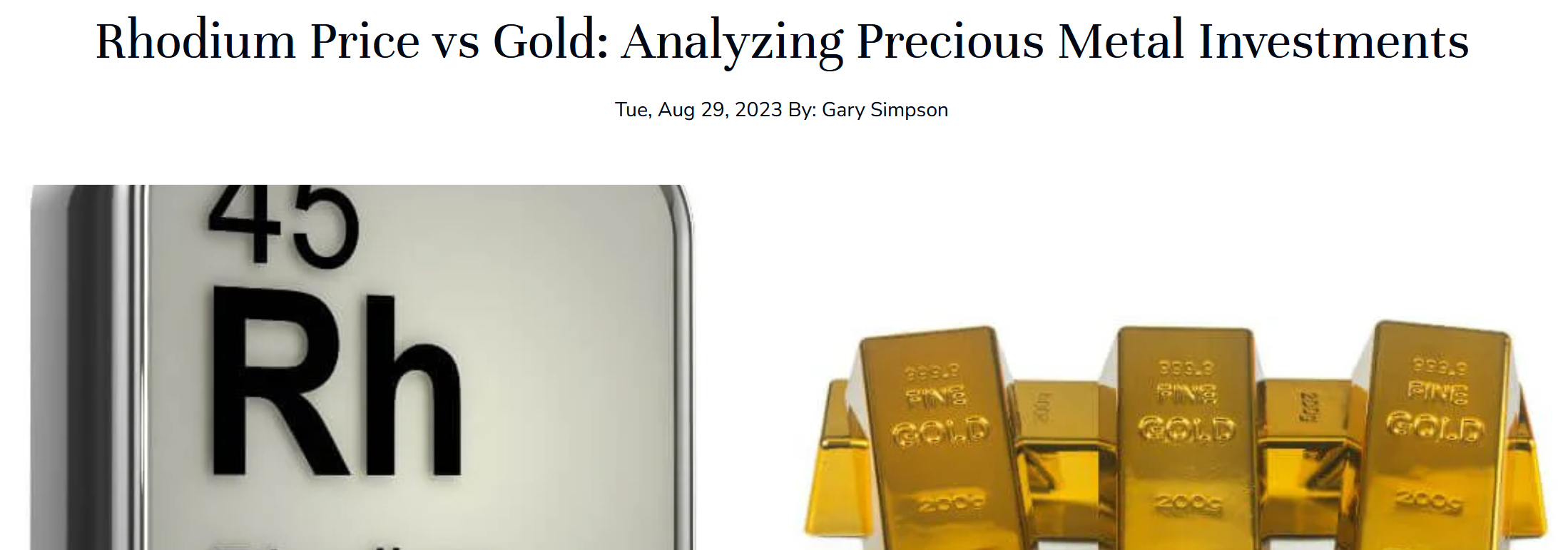
Shared from the research of: Joseph Mercado🔎
Article Author: Gary Simpson🧑
Website: Diamonrensu 🌎
To: Element Lover 💙
Blog Post #1305
Keyword Category: Master Mind Minerals⛰
Universal Principle: Law of Metals🥉
Re: Rhodium 〰️
Question: Are you familiar with Rhodium
Article Read Duration: Approximately 5 minutes
Date and Time: Saturday, April 6, 2024 at 10:03 p.m .
Dear Element Lover,
Rhodium and gold, both coveted for different reasons, have distinct price trajectories.
Embark on an exploration of the economic dynamics and factors that define the value of these precious metals in the global market.
Rhodium and gold are both precious metals, often attracting investors and collectors alike due to their inherent value and unique properties.
As investment options, their prices are closely monitored, with changes in their value often having a significant impact on investors’ portfolios.
While gold has traditionally been viewed as a stable asset, rhodium price movements can be more volatile, presenting potential risks and rewards for those interested in the performance of these metals.
Table Of Contents:
- Historical Context
- Rhodium and Gold
- Market Dynamics
- Role of Currencies
- Exploring Other Precious Metals
- Rhodium and Gold as an Investment
- Regional Influence on Rhodium and Gold Prices
- Industrial Role of Rhodium and Gold
- Data Analysis for Rhodium and Gold Prices
- Rhodium’s Unique Characteristics
- Future Predictions for Rhodium and Gold Prices
- Frequently Asked Questions
Comparing rhodium and gold prices can provide valuable insights into the behavior of these metals within financial markets.
Gold prices have a history of being determined through trading in the gold and derivative markets, while rhodium prices reflect changes in supply and demand in the automotive industry, as it is a key component in catalytic converters.
With their unique demand patterns and market drivers, understanding the price relationship between gold and rhodium can enhance investment strategies and help in making informed decisions.
These two metals have experienced varying price trends over time, often influenced by factors such as global economic conditions, geopolitical tensions, and technological advancements.
For instance, platinum and rhodium prices exhibited notable fluctuations at the beginning of the 1990s, according to a study discussing bubbles in metal prices.
By examining these price dynamics, investors can gain a better understanding of the factors that influence the value of these precious metals and make educated decisions in their investment activities.
Historical Context of Rhodium and Gold Prices:
Rhodium and gold are both precious metals that have been traded and valued for centuries. However, their prices have followed different patterns throughout history due to their unique properties and uses.
Gold has been a recognized standard of wealth and a store of value for thousands of years.
It’s history as a form of currency dates back to ancient civilizations, and it has been used to create coins, jewelry, and various other products.
The historical chart demonstrates that gold prices have experienced ups and downs, often influenced by factors such as inflation, political events, and economic conditions.
Rhodium, on the other hand, was discovered more recently in 1803 and has not been as extensively used or traded as gold.
Rhodium’s primary use is in catalytic converters for automobiles, which has made its demand and price much more dependent on industrial needs.
Additionally, rhodium is much rarer than gold, which contributes to its dynamic price fluctuations.
In the past, rhodium has been valued at a price roughly three times that of gold, according to a 20th-century perspective.
Both metals have experienced speculative bubbles, although gold has had more significant bubble episodes, as seen in the historical events surrounding metal prices.
The differing uses and rarity of rhodium and gold have contributed to their unique price movements over time, and it is crucial to consider these factors when comparing their historical prices.
In summary, while both rhodium and gold hold their values as precious metals, their respective histories, uses, and rarity have led to differing price patterns over time.
This historical context can provide valuable insights for investors and traders when considering the relationship between rhodium and gold prices in the current market.
Rhodium and Gold: A Comparison:
Rhodium and gold are both well-known precious metals, yet they have distinct characteristics that set them apart.
In this section, we will examine the similarities and differences between these two metals, including their prices, uses, and market behaviors.
Firstly, let’s address the price differences between rhodium and gold.
Rhodium is considerably rarer than gold, which directly impacts its price.
As of August 2021, the price of rhodium has reached over $19,000 per ounce, while gold’s price hovers around $1,800 per ounce.
It’s essential to keep in mind that the prices of precious metals, including rhodium and gold, can fluctuate significantly due to various factors such as global economic conditions and market demand.
Another critical difference between rhodium and gold is their uses.
Gold is widely utilized for various purposes, from jewelry and coin production to electronic components and even medical treatments.
In contrast, rhodium’s primary applications are within the automotive industry as a catalyst in catalytic converters to reduce harmful emissions.
Additionally, rhodium is occasionally employed as a coating for other metals, like white gold, to improve their durability and appearance.
The demand for rhodium and gold also differs. Gold enjoys a more stable demand due to its diverse range of applications and historical status as a store of value.
Central banks, investors, and individuals alike all contribute to the steady demand for gold.
Conversely, rhodium’s demand is primarily driven by industrial needs, making it more susceptible to fluctuations based on changes in the automotive market and emerging environmental regulations.
From an investment perspective, both rhodium and gold have their risks and rewards.
Gold typically performs well during economic downturns, and it’s considered a “safe-haven” investment due to its long-standing reputation as a store of value.
Rhodium, on the other hand, can experience dramatic price swings due to its rarity, limited supply, and industrial demand.
While rhodium may offer higher potential returns, it’s important to note that it carries higher investment risks as well.
To summarize, rhodium and gold are two distinct precious metals, each with its unique attributes, uses, and market behaviors.
While gold is a highly sought-after commodity with a stable demand, rhodium’s value is primarily derived from its industrial applications and scarcity.
Understanding the differences between these metals is crucial for making informed decisions in their respective markets.
Understanding Market Dynamics:
The rhodium and gold markets are influenced by a variety of factors that affect the prices of these precious metals.
Market players like investors, exchanges, and economic indicators like the NYSE and S&P 500 play significant roles in shaping these markets.
Both rhodium and gold have a strong presence in the financial markets due to their valuable applications.
While gold’s traditional role as a safe-haven investment is well-known, rhodium is gaining prominence for its growing use in automotive catalytic converters and other industrial applications.
This makes the dynamics of their prices an important point of discussion for investors.
Market factors: Supply and demand imbalances can significantly impact the prices of rhodium and gold in the market.
Changes in mining production, recycling rates, and the introduction of new technologies can all cause shifts in the market balance, affecting prices accordingly.
For example, the price of rhodium increased in recent years due to rising demand for the metal in automotive catalytic converters.
Investors: Investor sentiment and their buying and selling decisions can drive the prices of rhodium and gold. As investment instruments, price trends in these markets can be influenced by changes in investment portfolios or speculative trading.
Exchanges: The prices of rhodium and gold are heavily influenced by the activities on major exchanges like the NYSE and other global trading platforms.
These exchanges facilitate the buying, selling, and trading of precious metals, helping to determine their value in the global market.
Economic Indicators:
Like other financial markets, the precious metals market is tied to the performance of the broader economy.
Changes in the NYSE or the S&P 500 can signal shifts in investor sentiment and affect the demand for precious metals, causing price fluctuations for both rhodium and gold.
In conclusion, understanding the various factors that drive the market dynamics of rhodium and gold is crucial for investors looking to make informed decisions in these markets.
As global economies and technological advancements continue to evolve, it’s essential to remain updated on market trends and anticipate changes in precious metal prices.
Role of Currencies in Rhodium and Gold Pricing:
The pricing of precious metals like rhodium and gold is significantly influenced by currency movements.
Major currencies such as the USD, EUR, GBP, CHF, JPY, HKD, BRL, INR, MXN, RUB, and ZAR, play a major role in determining the international prices of these metals.
Since rhodium and gold are traded globally, exchange rates fluctuations profoundly impact their prices.
The USD is particularly important in the pricing of rhodium and gold, as these metals are usually priced in US dollars per troy ounce (XAU).
Investors worldwide monitor the USD’s movements to gauge the potential impact on the prices of rhodium and gold.
A stronger USD often translates to lower prices for these metals, while a weaker dollar might result in increased prices.
This is because a stronger dollar decreases the purchasing power of other currencies, making it more expensive for investors to buy rhodium and gold.
Apart from the USD, other major currencies like the EUR, GBP, AUD, and CHF also have substantial influence on rhodium and gold prices.
Fluctuations in these currencies can impact the demand for these precious metals in their respective regions, thereby affecting global prices.
For instance, when the EUR weakens against the USD, European investors might find it more expensive to buy gold or rhodium, potentially leading to decreased demand and lower prices.
Currency risks often encourage investors to diversify their portfolios by including precious metals like rhodium and gold.
These metals are perceived as safe-haven assets that can help mitigate currency fluctuations and protect investors’ wealth.
In times of economic uncertainty or geopolitical tensions, investors may seek refuge in rhodium and gold, driving up their prices as demand for these assets increases.
In summary, the movement of currencies, especially the USD, plays a crucial role in the international pricing of rhodium and gold.
Exchange rates fluctuations across major currencies such as the EUR, GBP, AUD, CHF, JPY, and others can impact the demand for these precious metals, ultimately affecting their prices.
Owing to their nature as safe-haven assets, rhodium and gold often serve as a tool for investors to hedge against currency risks and market volatilities.
Exploring Other Precious Metals:
When comparing the prices of rhodium and gold, it is important to consider other precious metals as well.
Notably, the markets for platinum, palladium, and silver show different trends and intrinsic qualities that may influence investment decisions.
Platinum, like rhodium, belongs to the platinum group metals (PGMs) and is widely used in the automotive, jewelry, and industrial sectors.
Since Platinum and rhodium belong to the same group, their performances on the market can be somewhat similar. Historically, the price of platinum has often exceeded that of gold, although the trend has not been consistent in recent years.
Palladium is another platinum group metal and finds its primary use in the automotive industry, like rhodium and platinum.
The price of palladium surged in the past few years due to its high demand especially from the automotive industry.
However, this trend has also been experiencing fluctuations, and predicting the future course of palladium prices remains a challenge.
Silver, while not part of the platinum group metals, is also an important precious metal to consider.
Known for its wide range of uses, from jewelry to electronic components, silver has a more affordable price point compared to gold and platinum.
Investors often view silver as an accessible option to diversify their investment portfolio.
In times of economic uncertainty, silver has shown to perform well as a safe haven asset, although its potential returns may not match those of gold.
In summary, the precious metal market incorporates various metallic elements such as gold, rhodium, platinum, and silver, each offering unique factors to consider when investing.
While the price trends of these metals vary over time, understanding their roles in different industries can provide valuable insights for investors who wish to diversify their portfolios.
Rhodium and Gold as an Investment:
Rhodium and gold are both valuable commodities in the world of precious metals.
Investors often view them as a way to diversify their portfolios and protect their money against inflation, economic uncertainty, or currency fluctuations.
Both metals have unique properties that make them attractive in different ways.
Rhodium is a highly valuable and rare metal, significantly rarer than gold. It is mainly used as a catalyst in automotive catalytic converters, thus is in high demand due to its role in reducing harmful emissions.
This demand impacts the price of rhodium, making it a more volatile investment compared to gold.
Additionally, its price can be affected by various factors such as changes in emission standards, the automotive industry, and geopolitical issues.
Rhodium has displayed significant price fluctuations in the past, which may appeal to investors seeking to capitalize on potential gains in a short period.
On the other hand, gold is a well-known and widely traded commodity.
Its stability and historical position as a store of value make it an attractive choice for investors seeking a more predictable investment option.
Gold is often seen as a safe-haven asset due to its limited correlation with other assets, making it an ideal candidate for hedging against risks in the market.
Investing in rhodium and gold can take various forms, such as buying physical bullion, trading futures contracts, or purchasing shares in mining companies or exchange-traded funds (ETFs) that focus on precious metals.
It is essential that investors carefully consider their risk tolerance and investment goals when deciding between these two commodities.
In summary, rhodium and gold both offer attractive opportunities for investors looking to diversify their portfolios or hedge risk.
The choice between the two depends on one’s investment objectives and appetite for risk.
While rhodium may offer the potential for higher returns, it also comes with increased volatility compared to the more stable and well-established investment option of gold.
Regional Influence on Rhodium and Gold Prices:
South Africa plays a significant role in the global rhodium market, as it holds the largest reserves of this precious metal.
The country contributes to around 80% of the world’s rhodium production.
Consequently, any changes in South Africa’s economic or political landscape can have a substantial impact on rhodium prices.
For instance, labor strikes and power outages in the mining sector have previously led to supply disruptions and increased prices.
Russia is another significant player in the rhodium market, albeit with a smaller contribution compared to South Africa.
Russia is known for its vast reserves of platinum group metals (PGMs), including rhodium. Fluctuations in their mining output can influence the global availability of rhodium, thus affecting its price.
As for gold, China and Australia are among the top producers globally.
China is the world’s leading gold producer, with a consistently growing output, which influences global gold prices.
Any shifts in China’s economic policies, regulations, or demand patterns can reverberate through the international gold market.
Australia, on the other hand, is known for its extensive gold mining operations and high-quality deposits.
The country’s production levels and mining investments can impact the global gold supply and, consequently, gold prices.
The London market plays a pivotal role in determining the price of both rhodium and gold.
The London Metal Exchange (LME) and the London Bullion Market Association (LBMA) set benchmarks and standards for these precious metals’ trading.
The LME and LBMA pricing mechanisms take various factors into account, such as supply and demand, macroeconomic indicators, and geopolitical events.
Thus, the London market serves as a barometer for global rhodium and gold price trends.
In conclusion, regional influences from South Africa, Russia, China, Australia, and London significantly impact rhodium and gold prices.
Monitoring events and developments in these regions can provide valuable insights into the direction of the precious metals market.
Industrial Role of Rhodium and Gold:
Rhodium and gold, two precious metals, play significant roles in various industries.
Rhodium, primarily known for its use in the automotive industry, is an essential component in catalytic converters.
These devices help reduce harmful exhaust emissions by converting them into less toxic substances before releasing them from the vehicle’s exhaust system.
This unique application makes rhodium highly valuable in limiting pollution and adhering to strict emissions standards1.
In contrast, gold is a highly sought-after metal due to its corrosion-resistant properties.
It is used in several industries, such as electronics, where it serves as an ideal conductor for electrical contacts and connectors.
Additionally, gold has applications in aerospace, particularly in aircraft turbine engines, where it is used for thermal insulation and electrical connections2.
Both rhodium and gold enjoy high demand from different sectors. While rhodium has a more specific role in the automotive industry, gold boasts versatility in its applications.
Their shared corrosion-resistant properties make them ideal materials for use in harsh environments where longevity and reliability are crucial.
Though gold is often recognized for its traditional uses in jewelry and finance, it should not be overlooked for its importance in various industries.
At the same time, rhodium’s critical role in mitigating air pollution underscores its value as an industrial metal.
Data Analysis for Rhodium and Gold Prices:
Costliest Metals:
As of July 2023, these are the five most expensive metals:
- Rhodium (Rh) – $15,250/troy ounce
- Iridium (Ir) – $4,750/troy ounce
- Palladium (Pd) – $2,027/troy ounce
- Gold (Au) – $1,723.55/troy ounce
- Platinum – $889/troy ounce
A careful analysis of rhodium and gold prices is essential to understanding their market trends and potential future movements.
Rhodium and gold prices have shown different behavior over time due to their respective supply and demand dynamics.
However, a comparative analysis can provide valuable insights into their market performance and potential investment opportunities.
A historical examination of rhodium prices reveals that the metal has experienced significant fluctuations, often displaying a higher degree of volatility compared to gold.
The reason for this behavior is mainly due to rhodium’s rarity and its specialized applications, such as its use in the automotive industry for catalytic converters.
Unlike gold, rhodium is not considered a traditional store of value or a common investment vehicle, which contributes to its price volatility.
On the other hand, gold prices have demonstrated a more stable and predictable trend over time.
Gold is widely recognized as a safe-haven asset and an effective hedge against inflation, leading to more consistent demand and less volatile prices.
Nonetheless, gold prices can still experience short-term fluctuations due to factors such as geopolitical events, changes in interest rates, and market sentiment.
Recent advancements in data-driven techniques have provided new opportunities for predicting future gold rates.
For instance, researchers have employed machine learning approaches using 22 market variables for accurately predicting daily gold rates.
However, predicting rhodium prices remains a challenging task due to its smaller market, specific industrial applications, and the limited research available.
Despite this challenge, an analysis of the existing price data can still provide valuable insights that may enable investors and industry experts to make informed decisions in the future.
In conclusion, a comprehensive data analysis of rhodium and gold prices is essential for understanding their respective market trends and identifying potential investment opportunities.
While both precious metals show distinct price behaviors, examining their historical correlations and driving factors can provide valuable information for market participants.
Rhodium’s Unique Characteristics:
Rhodium is a rare and valuable metal, often compared to gold in terms of its price and unique properties.
This precious metal is primarily used in the automotive industry as a catalyst to reduce harmful emissions.
Rhodium production is relatively low, with annual output typically ranging from a few hundred to a couple thousand metric tons.
In comparison, gold production amounts to thousands of metric tons per year, highlighting the significant difference in rarity between the two metals.
One of the key characteristics of rhodium is its resistance to corrosion and tarnish.
It is an extremely durable metal, with a beautiful silvery-white appearance, which makes it desirable for both industrial and jewelry applications.
Rhodium is also a symbol of wealth and exclusivity, often used to plate gold or silver jewelry, giving them a bright and shiny finish while enhancing their durability.
The rarity of rhodium compared to gold can be attributed to its relatively limited geographic distribution, primarily originating from South Africa, Russia, and Zimbabwe.
The challenging extraction process also contributes to its scarce availability.
Rhodium is usually found in ores mixed with other platinum group metals and requires complex separation techniques to isolate the metal in its pure form.
Rhodium’s price has historically been more volatile than gold, experiencing dramatic fluctuations based on changes in supply, demand, and economic factors.
For investors looking to diversify their precious metals portfolio, rhodium offers an alternative option with potential for significant returns, given its unique characteristics and value proposition.
In summary, rhodium stands out as a distinct and valuable metal with several unique characteristics, such as its rarity, resistance to wear, corrosion, and its role as a symbol of wealth.
The metal’s exceptional properties and limited production make it a sought-after commodity by both industry players and investors alike.
With a focus on responsible mining practices and sustainable resource management, rhodium will continue to occupy an important alcove in the precious metals market.
Future Predictions for Rhodium and Gold Prices:
Rhodium and gold are both precious metals that hold significant value in the market.
However, predicting their future prices can be a challenging task due to various factors influencing the market dynamics.
Employing methods like machine learning and econometric models can provide insights into the possible price fluctuations of these metals.
One study on predicting future gold rates using machine learning approaches has demonstrated that certain algorithms can help forecast gold prices with a reasonable degree of accuracy. As a result, investors can make informed decisions on when to buy or sell gold.
Similarly, forecasting models can be developed for rhodium prices.
As these models often take into account factors like global economic indicators, government policies, and industrial demands, they can provide valuable insights into rhodium price trends.
For instance, the price of rhodium may be influenced by changes in government policies affecting the automobile industry, since rhodium is used extensively in catalytic converters.
Kitco News, a leading provider of precious metals information, can offer a useful source of data for forecasting the future prices of rhodium and gold, as they provide real-time market insights and in-depth analysis.
Additionally, price trends of rhodium and gold can also be tracked using indices such as the Toronto Stock Exchange (TSX), which provides an accessible platform for tracking and investing in these commodities.
In summary, future predictions for rhodium and gold prices can be made using advanced methodologies and reliable data sources such as machine learning algorithms, econometric models, Kitco News, and the Toronto Stock Exchange.
These predictions can help investors be more confident in their decision-making process when it comes to investing in these precious metals.
Frequently Asked Questions:
How do gold and rhodium prices compare?
Gold and rhodium prices tend to fluctuate over time, and their values can be quite volatile. Historically, gold has been considered a less volatile and more stable investment option.
Rhodium, on the other hand, can experience sudden and significant price increases and decreases, making it a riskier investment choice.
However, there have been times when rhodium prices have exceeded gold prices due to various market factors.
What factors influence rhodium and gold prices?
Several factors can influence the prices of rhodium and gold. For gold, these factors include global economic stability, geopolitical events, inflation, and supply and demand.
Rhodium prices are influenced by factors such as industrial production, technological advancements, and the state of the automotive industry, as rhodium is used predominantly in catalytic converters for emission reduction.
Are rhodium and gold interchangeable as investments?
While both rhodium and gold are considered precious metals, they are not interchangeable as investments due to their distinct properties and market factors.
Gold is often seen as a safe-haven investment and a hedge against inflation, with a historical track record of maintaining its value over time.
Rhodium is a more volatile and riskier investment, primarily driven by its industrial applications.
Investors should consider their risk tolerance and investment objectives when comparing the two metals.
What drives the historical price difference between rhodium and gold?
The historical price difference between rhodium and gold is driven by multiple factors, including their unique uses, supply and demand dynamics, and market perceptions.
Gold has been a widely recognized store of value for centuries and is utilized in various industries, such as jewelry, electronics, and dentistry.
Rhodium’s primary use is in the automotive industry, making its price more sensitive to changes in industrial production and technological advancements.
How do the uses of gold and rhodium affect their prices?
The uses of gold and rhodium have a significant impact on their prices. Since gold has a diverse range of applications across various industries, its demand remains relatively steady, contributing to its price stability.
In contrast, rhodium’s price is more affected by its industrial applications, particularly in the automotive industry.
As a result, changes in production levels or new emission control technologies can have a significant impact on rhodium prices.
Why might one choose to invest in rhodium over gold?
An investor might choose to invest in rhodium over gold in situations where they believe the risk-reward potential is more favorable.
Rhodium’s price can experience significant increases during periods of high demand and limited supply, potentially providing investors with substantial capital gains.
However, this investment choice comes with higher risks due to the metal’s price volatility and sensitivity to industrial trends.
Investors should carefully evaluate their risk appetite and investment goals before selecting rhodium over gold.
Visit the Website Here

 Email Us a Message
Email Us a Message 

Please send us a personal message below and we will serve you momentarily.
Allow MMU to help educate you with knowledge and wisdom using experiences as the bridge.
Learn how to become a successful entrepreneur through the online education portal of MMU
Do you know someone who can benefit from this article
If so….
Please share Rhodium vs Gold with your family, friends, colleagues, and business partners
We appreciate you visiting the MMU Global Research Directory
Thank You.
For more blog posts, videos, articles and to generate more knowledge, please feel free and…












 Fly Over to the MMU Facebook Page with Hoot
Fly Over to the MMU Facebook Page with Hoot 

 Join the MMU Facebook Group Today
Join the MMU Facebook Group Today 